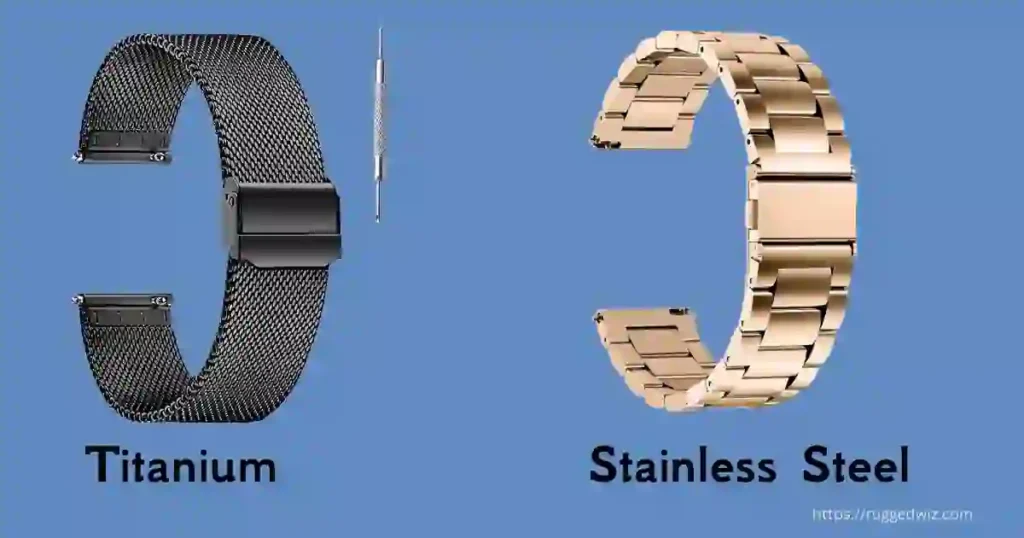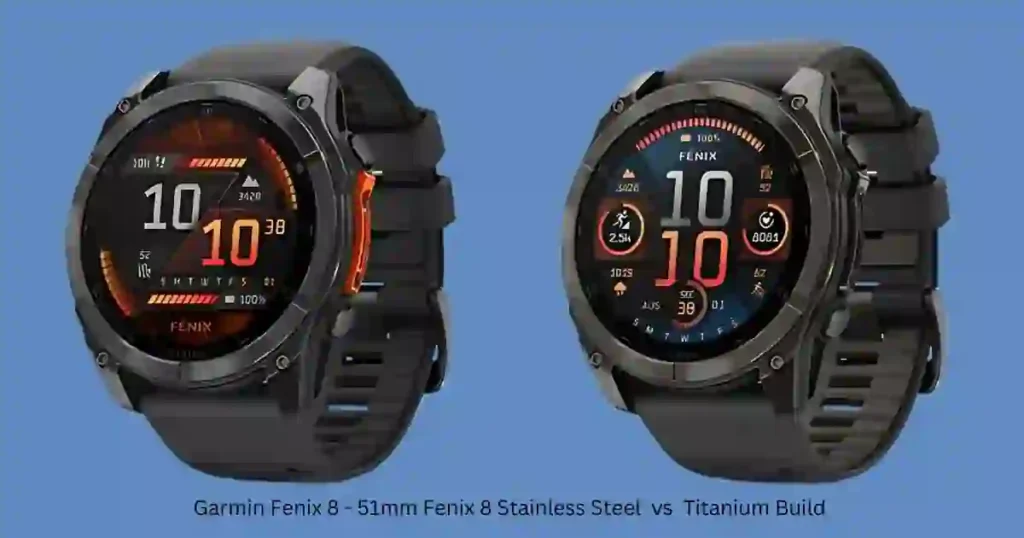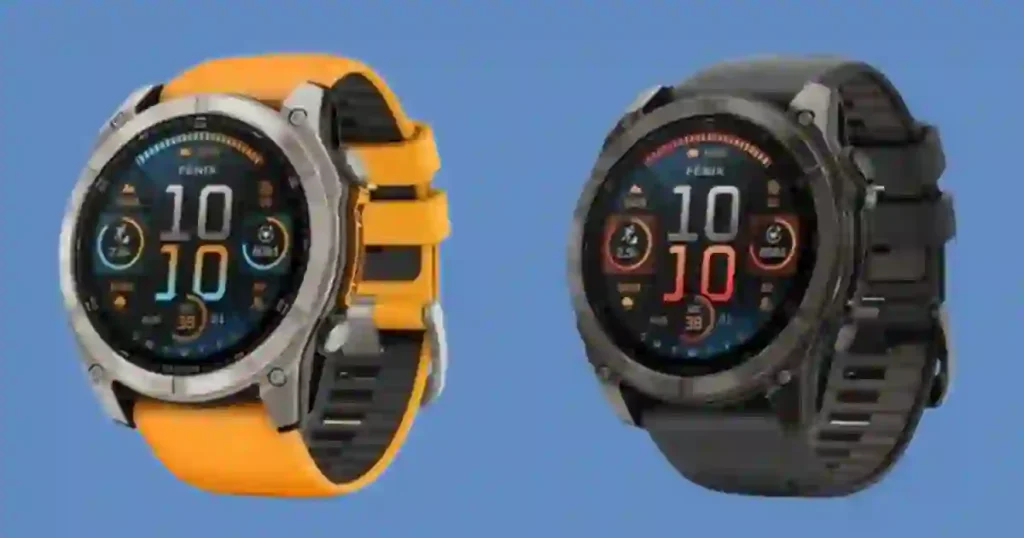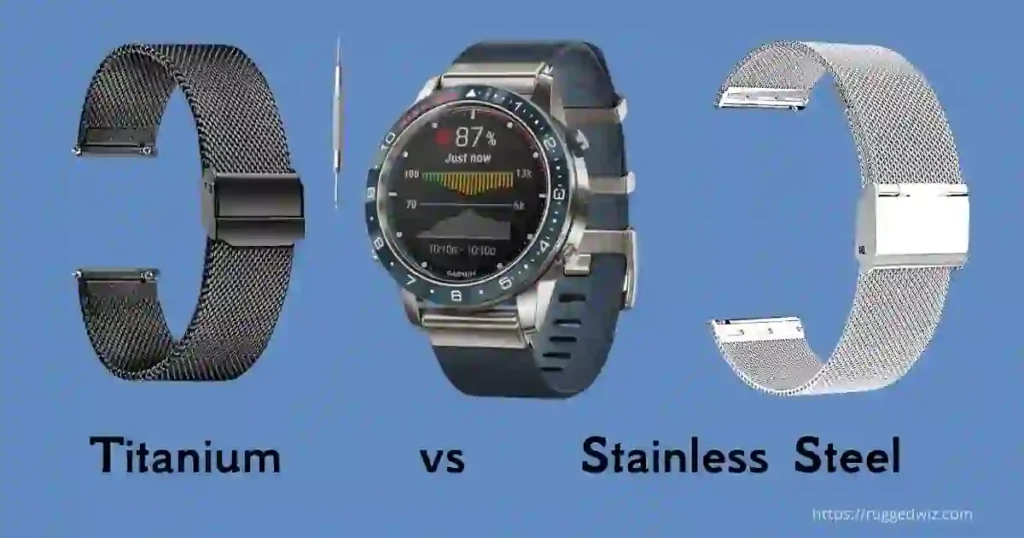Buying a Garmin watch, some of the most important questions that are often overlooked could be whether to choose between stainless steel and titanium, especially when it comes to the bezel or the lens, or in general.
Whether you build houses, work outdoors, or are an athlete in need of a watch that keeps up with your active lifestyle, or simply someone looking for a dependable time-keeping device, knowing your Garmin watch materials is paramount. Garmin has different choices for both materials. And each choice gets significant say over the bike watch’s durability, weight, looks, and price.
Let’s look closer at the materials Garmin watches use: stainless steel vs. titanium, including the pros and trade-offs that come with each option.
Quick Overview: Stainless Steel vs Titanium Materials in Garmin Watches
| Feature | Stainless Steel | Titanium |
| Weight | Heavier, feels more substantial | Titanium is lighter, more comfortable for long wear |
| Durability | Strong, but can show scratches over time | Very strong, but more prone to scratches |
| Cost | More affordable | More expensive |
| Appearance | Shiny, classic finish | Matte or brushed finish, often paired with sapphire lens |
| Scratch Resistance | High, but may show marks over time | Less resistant to scratches than stainless steel, but resistant to corrosion |
| Best For | Those seeking durability at a lower cost | Those seeking a premium, lightweight option |
Below is a detailed guide to help you dive deeper into the materials and make an informed decision on the best Garmin watch for you.
Garmin Bezel Materials: Stainless vs. Titanium
One of the primary differences between stainless steel vs. titanium in a Garmin is the basic material used for the bezel. Generally, Garmin provides two major bezel options in most of the lines: stainless steel and titanium.
The main differentials in the material used for making the watch’s bezel affect the feel, appearance, and performance of the timepieces.

Stainless Steel Bezel
Stainless steel, on the other hand, is probably more traditional. Its brilliance in polished finishes makes a watch look luxurious and somewhat desirable to most people on the owner’s wrist. Its stainless steel bezels also share Gorilla Glass lenses, which are known for their impact resistance, up to being durable.
While not as scratch-resistant as sapphire, this Gorilla Glass lens provides brilliant clarity and better light transmission, thus making it a good choice for visibility in outdoor recreation.
Titanium Bezel
For instance, titanium has more lightweight properties and would be suitable for people who wear their watch daily and prefer wearing them while running, hiking, or taking part in some outdoor sport activities. Garmin puts Grade 2 titanium into most models. It has a natural silver colour.
It’s softer and more scratch-prone than stainless steel, but all surface scratches can easily be buffed out. Garmin also offers DLC-coated titanium, which provides a darker finish and adds extra strength and scratch resistance.
But while DLC-coated titanium is *incredibly* though, the scratches that do work their way through are more noticeable and more difficult to repair.
A perfect example of this is the Garmin Fenix 8, which is available in both stainless steel and titanium at 51mm. The stainless steel version weighs about 74g, while the pure titanium version weighs about 64g, a difference of about 10g.
This isn’t as evident when looking at it; on the other hand, though, this gives much more comfort to users who wear their watches for long periods of time.
Weight of Titanium vs. Stainless Steel Watch
One of the biggest differences when comparing titanium versus stainless steel watches has to do with the weight. It is much lighter than stainless steel, due to its excellent strength-to-density ratio, which makes it a great material. This is very useful for those who wear their watch all day long or use it during outdoor activities.
Titanium Watches: Generally, the feel of a wristwatch made from titanium is much lighter on the wrist. Garmin’s titanium Garmin watches are great for those who need comfortable, long-wearing options.
For instance, Grade 5 titanium used in Garmin’s premium Marq line brings strength as found in stainless steel without letting go of light weight, making it a premium option without any heavy or bulky feel.
Stainless Steel Watches: These also feel more substantial, which is a positive attribute to those who enjoy that somewhat heavy feeling from a thick watch. While this extra weight is barely noticed when daily worn, it certainly does get a bit more cumbersome on those long runs or during hiking.
Scratch Resistance: Is Titanium or Stainless Steel Better?
In terms of scratch resistance, both materials are quite durable, yet there lie key differences in how each performs with time.

Scratch Resistance of Titanium: While it is resistant to scratching, Grade 2 used on most Garmin lines is softer and less harder than steel. That means that over time, it is more apt to reveal superficial scratches than stainless steel does, especially when pitted against harsh environments.
However, scratches can normally be buffed out by a jeweller. All in all, DLC-coated titanium offers better scratch resistance, but that does not mean it can never get scratched.
Scratch Resistance Stainless steel is harder and tough compared to titanium. As a result, most of the time, it’s more resistant to scratches. The stainless steel looks more polished, but after some time, slight scratches begin to appear.
This becomes of great significance if your watch is with you in harsh conditions. However, stainless steel is actually quite polishable, and this allows for keeping your watch new-looking with routine maintenance.
For users who need the most scratch resistance, sapphire glass-I usually find it in titanium Garmin watches-is way more resistant to scratches than any Gorilla Glass. While the latter is highly resistant to impacts and subsequent shatters, it is really not that resistant to scratches. On the other hand, sapphire glass is virtually scratch-free and provides advanced protection from wear and tear.
Durability: How Do Stainless Steel and Titanium Compare?
Both these metals, titanium and stainless steel, are extremely strong, yet each has different strengths.

Wear Resistance of Titanium: It has excellent resistance to corrosion and the highest strength-to-weight ratio. If extreme outdoor exposure involves frequent exposure to saltwater, sweating, or even humidity, then it’s the perfect fit for those extreme outdoor enthusiasts.
Garmin’s options in Garmin watches with Grade 5 titanium ensure extra strength while maintaining its lightness. This is another major reason why a titanium watch becomes an excellent choice for adventurers who search for performance without being weighed down.
Stainless Steel Durability: From all viewpoints, stainless steel has more strength and higher tensile strength than Titanium, which contributes to more resistance against bending or otherwise deforming. Being exposed to saltwater over extended periods will render stainless steel prone to rust; on the other hand, titanium is resistant to corrosion.
Whatever be the case, the Garmin stainless steel watches are quite durable and will serve good time for users in most environments; they may not do as well as titanium under extreme conditions.
Additional Considerations for Titanium in Garmin Watches
DLC-Coated Titanium
Garmin offers DLC coating for their titanium watches, which is far sleeker and darker, adding a great deal of strength and scratch resistance to the material. This puts a unique aesthetic on the material, making it much more matte and robust compared to regular ones.
While the DLC coating provides increased durability compared with uncoated titanium, one should not be misinformed the DLC-coated titanium scratches too. Any marks that do tend to appear are usually more visible and very difficult to buff out compared to the softer, uncoated titanium, which can be polished more easily.
Grade 5 Titanium
Grade 5 titanium, used in Garmin’s high-end Marq line of watches exclusively, is an alloy of titanium with extra metals added, such as aluminium and vanadium. This makes the material far stronger and scratch-resistant, thus being stronger than traditional stainless steel yet still having all the lightness in weight from the titanium so that it will wear easily on the wrist.
However, Grade 5 titanium is more expensive than the more common Grade 2, which is most often used in many Garmin models due to its relatively more expensive processes and performance.
Lens Materials: Sapphire vs. Gorilla Glass
Such a choice of lens material in Garmin watches is closely interconnected with the type of bezel material. Even though Garmin watches can use either Gorilla Glass or Sapphire Glass, each of them has some advantages and disadvantages.
Gorilla Glass
Used more often for watches with stainless steel bezels, Gorilla Glass is robust and resistant. It’s good at sustaining strong impacts without shattering, therefore coming in handy for active users who are sometimes afraid of dropping their watch or hitting it with something.
Though it is not as scratch-resistant as sapphire, it does offer better clarity since the light transmitted through it is much clearer, hence very tempting for those users who give higher priority to screen clarity rather than scratch resistance at its best.
Sapphire Glass
The sapphire glass is classified as one of the toughest materials for watch lenses and applied in Garmin’s Titanium watches. It is basically scratch resistant, hence very durable for those users who want to avoid scratches either from daily wear or rough environments.
Whereas sapphire glass may be a little less clear than Gorilla Glass because of its hardness, the gap in clarity is often imperceptible during regular use.
The most important advantage of sapphire glass is that it resists scratching so much better than almost any other lens materials and offers more durability for those worried about the glasses for years to come.
Price Consideration: Is Titanium Worth the Extra Cost?
Most people face a dilemma when it comes to choosing between a titanium and stainless steel Garmin watch based on the costs. Normally, the former is offered at higher prices due to, primarily, the cost of the material itself, supporting sapphire glass, and other added advantages in durability.
Consider the 51mm Garmin Fenix 8 in stainless steel at about $1,099 and find the same derivation in titanium at $1,199, which is a hundred dollars more. At this price, it can boast light weight, more resistance to corrosion, and scratch resistance-so attractive for those users who highly value these aspects.
However, if price sensitivity is a concern and the extra weight of stainless steel is not a big issue, then the models made of stainless steel/Gorilla Glass are still very high-performing for wearables. It gives great value without the extra cost accorded to titanium.
While some Garmin models, such as the Fenix and Epix series, are made from either bezel material option, not all Garmin watches give you an option for which one you want. The right model is going to depend on what you need most: a lighter watch with potentially better scratch resistance or an economical one that can withstand the rigors of day-to-day life.
Conclusion: Stainless Steel Vs Titanium Materials In Garmin Watches
Which one to go for, titanium or stainless steel, greatly depends on your priorities when buying your next Garmin watch. If you will be using it for hard-core outdoor activities, then Garner titanium with sapphire glass is a great choice. Although it costs a bit more, the extra durability, lighter weight ,corrosion resistance and comfort make it worth the investment. But it might scratch more easily.
On the other hand, if you like a weightier feel, want that actually classic polished look, or are on a somewhat tighter budget, it perhaps is now time to look into a stainless steel Garmin watch which is less expensive. The stainless steel watches are affordable watches and give very good scratch resistance, strength, and impact resistance. That makes them quite decent for everyday wear.
Ultimately, it’s all up to personal preferences and how you intend to use your Garmin watch. Whether it be the light, resilient titanium or the classic and strong stainless steel, Garmin comes out with fantastic choices for a wide range of users and lifestyles.
FAQS : Which is better titanium or stainless steel
What are the main differences between stainless steel and titanium in Garmin watches?
The main differences between stainless steel and titanium in Garmin watches would be in aspects of their physical properties and performance. For example, titanium is much lighter when compared with stainless steel, giving it great comfort as it will be worn for an extended period, especially in outdoor activities. On the other hand, stainless steel is generally more robust and highly hard, probably due to providing better scratch resistance. Ultimately, it will depend on the user’s preference in terms of weight, durability, and aesthetics.
Does Titanium Scratch Easily?
While titanium is very impressive in scratch resistance, it is not scratch-proof. Pure titanium can also be softer than some stainless steel alloys. That means it is more prone to scratches when pitted against particular elements or under special conditions. However, most Garmin watches with sapphire glass incorporated into a titanium bezel provide quite effective protection of the watch face.
Which is more durable for outdoor activities: is titanium harder than stainless steel?
Titanium is not harder than steel. Both are durable, yet both come with different needs. Titanium is more believed to be fit for outdoor recreation due to its light mass and excellent corrosion resistance. On the other hand, stainless steel gives a more rugged feel and holds up under strong usage, being an excellent choice if one desires a more solid look and feel. Again, the eventual decision between titanium and stainless steel will, however, come down to personal usage, whether it be out hiking or on more intense industrially-based tasks.
Also Like:-


